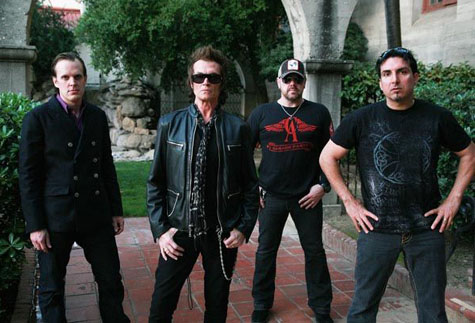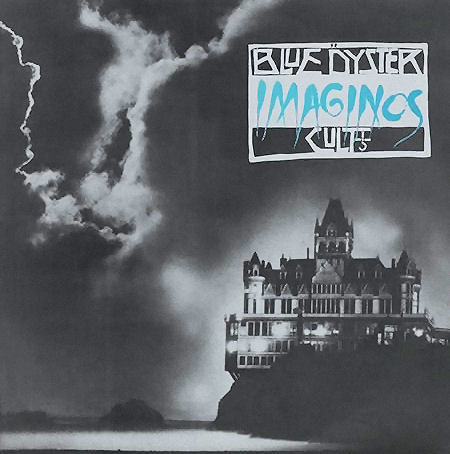TRACKLISTING:
1. Overture (8:09)
2. Daddy’s Gone (5:56)
3. Whosit, Whatsit and Which (6:33)
4. Make Way for the Big Show (8:42)
5. Tesseract (5:20)
6. Uriel (5:50)
7. Camazotz (6:22)
8. Ixchel (4:39)
9. The Battle for Charles Wallace (7:00)
LINEUP:
David Bobick – lead vocals
Jason Brower – drums, percussion, backing vocals
John Fontana – guitar, orchestral and incidental keyboards, keyboards (8)
Matt Masek – bass, cellos, backing vocals, 12-string guitar (2), nylon string guitar (8)
David Silver – keyboards
With:
Roo Brower – vocals (7, 8, 9)
Formed in 2006 in the New York/New Jersey area by guitarist/keyboardist John Fontana and vocalist David Bobick, Shadow Circus might have ended up as one of the many progressive rock projects limited to the four walls of a recording studio. Instead, right from day one, Fontana and Bobick’s vision involved a full-fledged band that would perform on stage as often as possible, emphasizing the theatrical component introduced in prog by Peter Gabriel-era Genesis (as well as some lesser-known outfits). Though not without hiccups (i.e. frequent lineup changes), the band have managed to hold to their initial aim, perfecting their stage craft whenever given the opportunity to play live.
Although often tagged as “retro-prog”, Shadow Circus are quite unlike the many outfits that sound like a tired retread of Seventies – albeit with a modern veneer. While their debut album, Welcome to the Freakroom, took an eclectic yet accessible approach, Whispers and Screams upped the ante in terms of “prog quotient”, half of it dedicated to the seven-part suite “Project Blue”, which, in its 34 minutes, summed up the band’s musical vision. On a Dark and Stormy Night (released on Georgia-based label 10T Records) takes up where “Project Blue” left off, expanding and developing the format in a compact 58 minutes, each track flowing organically into the other without any noticeable breaks, in classic “rock opera” style. Indeed, this is the first time that the band have taken the “concept album” route, basing their third recording effort on Madeleine L’Engle’s young adult fantasy novel A Wrinkle in Time – a fitting tribute on the book’s 50th anniversary. Literary inspiration is a fil rouge that runs through Shadow Circus’ six-year history– starting with the band’s own name, which references Ray Bradbury’s Something Wicked This Way Comes; additionally, “Project Blue” and “Journey of Everyman” (the 12-minute epic included on their debut album) are based on Stephen King’s The Stand and The Talisman.
Though concept albums as a whole, in spite of their enduring popularity with prog fans, can easily result in an overblown mess, Shadow Circus have navigated the potential pitfalls with admirable skill. The finished product is solid and cohesive, striking a fine balance between engaging melodies, fiery instrumental cavalcades and atmospheric, meditative moments. While a good proportion of the album is instrumental, the contrast with the generally catchier vocal parts is handled with a light touch, without creating the dreaded “patchwork” effect that mars many overly ambitious efforts.
Though Shadow Circus’ previous releases have often elicited comparisons to the obligatory Yes, Genesis and ELP (as well as more radio-friendly bands such as Kansas or Styx), On a Dark and Stormy Night develops the strong hard rock vein openly displayed on Whispers and Screams by tracks such as “Captain Trips” and “The Seduction of Harold Lauder”. In fact, the album’s core lies in remarkable synergy between John Fontana’s guitar – capable of sharpness, yet consistently melodic – and David Silver’s commanding keyboards, reminiscent of the epic duels between Ritchie Blackmore and Jon Lord immortalized by Deep Purple’s In Rock and Machine Head.
On a Dark and Stormy Night is bookended by two longish tracks with a deeply cinematic sweep, both of them referencing some of the main themes of the album. Introduced by ominous sounds of rain and thunder, “Overture” builds up slowly with orchestral grandeur and soaring guitar until it erupts in a wild guitar-organ ride in Deep Purple/Uriah Heep style. The following trio of songs showcase David Bobick’s confident delivery, rooted in AOR and classic rock rather than traditional prog. “Daddy’s Gone” juxtaposes a catchy, almost radio-friendly vein with a wistful note, enhanced by elegant piano and an emotional guitar solo at the end; while the jaunty pace and infectious chorus of “Whatsit, Whosit and Which” lead the way to a powerful Hammond solo. The longest track at over 8 minutes, “Make Way for the Big Show”- based on a theme composed by drummer Jason Brower – is a stately, melodic piece that combines an almost classical feel with suggestions of vintage Kansas and Supertramp, dominated by Silver’s splendidly flowing piano and Bobick’s soaring vocals.
The 5-minute rollercoaster ride of “Tesseract” is strategically placed in the middle of the album, signaling a shift into decidedly more adventurous territory. Eerie electronic effects complement echoing, chiming guitar lines that recall Porcupine Tree’s iconic style, then the Deep Purple vibe resurfaces for a fiery guitar-organ duel, adding a hint of Iron Maiden along the way. “Uriel” provides a momentary respite with the lyrical cello and piano at the beginning, then swiftly turns into an upbeat, dance-like tune enlivened by a great vocal performance by Bobick; while the martial, menacing pace of the über-eclectic “Camazotz” morphs first into a soulful, bluesy chorus, then into a space-rock workout that pushes Matt Masek’s powerful, dynamic bass into the spotlight together with the guitar and keyboards. The lovely “Ixchel” – a soothing moment with a haunting Celtic tinge – wordlessly conveys the healing atmosphere of the titular planet through gentle acoustic guitar, sparse piano and Roo Brower’s ethereal vocalizing. In sharp contrast, closing track “The Battle for Charles Wallace” surges along like a triumphant sci-fi soundtrack, spotlighting the intense keyboard-guitar interplay, while Brower’s imperious drums set the pace; then vocals return, reprising the “Big Show” theme, and an expressive guitar solo wraps up the album.
By an interesting coincidence, On a Dark and Stormy Night’s official release is scheduled just a few days before another adaptation of a well-known young adult novel – J.R.R. Tolkien’s The Hobbit. Though Shadow Circus’ third album will probably not meet with same worldwide success as Peter Jackson’s film, it will probably feature in quite a few “best of 2012” retrospectives. Impressively well-structured and cohesive from both a musical and lyrical point of view, the album shows a band that have finally attained full maturity. Although On a Dark and Stormy Night is quite unlikely to please everyone in the increasingly fragmented prog community – and those of an elitist bent would be well advised to handle with care – those who approve of paying homage to the golden age of prog without sounding like a carbon copy of those modes will find a lot to appreciate. This is also a good “gateway” album for fans of classic and hard rock, and obviously recommended to those who like musical adaptations of literary material.
Links:
http://www.shadowcircusmusic.com/








